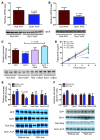Hepatic sortilin regulates both apolipoprotein B secretion and LDL catabolism
- PMID: 22751103
- PMCID: PMC3408750
- DOI: 10.1172/JCI63563
Hepatic sortilin regulates both apolipoprotein B secretion and LDL catabolism
Abstract
Genome-wide association studies (GWAS) have identified a genetic variant at a locus on chromosome 1p13 that is associated with reduced risk of myocardial infarction, reduced plasma levels of LDL cholesterol (LDL-C), and markedly increased expression of the gene sortilin-1 (SORT1) in liver. Sortilin is a lysosomal sorting protein that binds ligands both in the Golgi apparatus and at the plasma membrane and traffics them to the lysosome. We previously reported that increased hepatic sortilin expression in mice reduced plasma LDL-C levels. Here we show that increased hepatic sortilin not only reduced hepatic apolipoprotein B (APOB) secretion, but also increased LDL catabolism, and that both effects were dependent on intact lysosomal targeting. Loss-of-function studies demonstrated that sortilin serves as a bona fide receptor for LDL in vivo in mice. Our data are consistent with a model in which increased hepatic sortilin binds intracellular APOB-containing particles in the Golgi apparatus as well as extracellular LDL at the plasma membrane and traffics them to the lysosome for degradation. We thus provide functional evidence that genetically increased hepatic sortilin expression both reduces hepatic APOB secretion and increases LDL catabolism, providing dual mechanisms for the very strong association between increased hepatic sortilin expression and reduced plasma LDL-C levels in humans.
Figures





Similar articles
-
Macrophage sortilin promotes LDL uptake, foam cell formation, and atherosclerosis.Circ Res. 2015 Feb 27;116(5):789-96. doi: 10.1161/CIRCRESAHA.116.305811. Epub 2015 Jan 15. Circ Res. 2015. PMID: 25593281 Free PMC article.
-
Activation of ER stress and mTORC1 suppresses hepatic sortilin-1 levels in obese mice.J Clin Invest. 2012 May;122(5):1677-87. doi: 10.1172/JCI61248. Epub 2012 Apr 2. J Clin Invest. 2012. PMID: 22466652 Free PMC article.
-
Sortilin restricts secretion of apolipoprotein B-100 by hepatocytes under stressed but not basal conditions.J Clin Invest. 2022 Mar 15;132(6):e144334. doi: 10.1172/JCI144334. J Clin Invest. 2022. PMID: 35113816 Free PMC article.
-
Role of sortilin in lipid metabolism.Curr Opin Lipidol. 2019 Jun;30(3):198-204. doi: 10.1097/MOL.0000000000000598. Curr Opin Lipidol. 2019. PMID: 30946050 Review.
-
Shifting the LDL-receptor paradigm in familial hypercholesterolemia: novel insights from recent kinetic studies of apolipoprotein B-100 metabolism.Atheroscler Suppl. 2002 Mar;2(3):1-4. doi: 10.1016/s1567-5688(01)00012-5. Atheroscler Suppl. 2002. PMID: 11923121 Review.
Cited by
-
Angiopoietin-like 4 promotes intracellular degradation of lipoprotein lipase in adipocytes.J Lipid Res. 2016 Sep;57(9):1670-83. doi: 10.1194/jlr.M067363. Epub 2016 Mar 31. J Lipid Res. 2016. PMID: 27034464 Free PMC article.
-
Structural and functional analysis of APOA5 mutations identified in patients with severe hypertriglyceridemia.J Lipid Res. 2013 Mar;54(3):649-661. doi: 10.1194/jlr.M031195. Epub 2013 Jan 10. J Lipid Res. 2013. PMID: 23307945 Free PMC article.
-
PCSK9 as a Target for Development of a New Generation of Hypolipidemic Drugs.Molecules. 2022 Jan 10;27(2):434. doi: 10.3390/molecules27020434. Molecules. 2022. PMID: 35056760 Free PMC article. Review.
-
(Pro)renin Receptor Inhibition Reduces Plasma Cholesterol and Triglycerides but Does Not Attenuate Atherosclerosis in Atherosclerotic Mice.Front Cardiovasc Med. 2021 Dec 24;8:725203. doi: 10.3389/fcvm.2021.725203. eCollection 2021. Front Cardiovasc Med. 2021. PMID: 35004870 Free PMC article.
-
Genetics-driven discovery of novel regulators of lipid metabolism.Curr Opin Lipidol. 2019 Jun;30(3):157-164. doi: 10.1097/MOL.0000000000000605. Curr Opin Lipidol. 2019. PMID: 30985365 Free PMC article. Review.
References
Publication types
MeSH terms
Substances
Grants and funding
LinkOut - more resources
Full Text Sources
Other Literature Sources
Molecular Biology Databases
Miscellaneous

